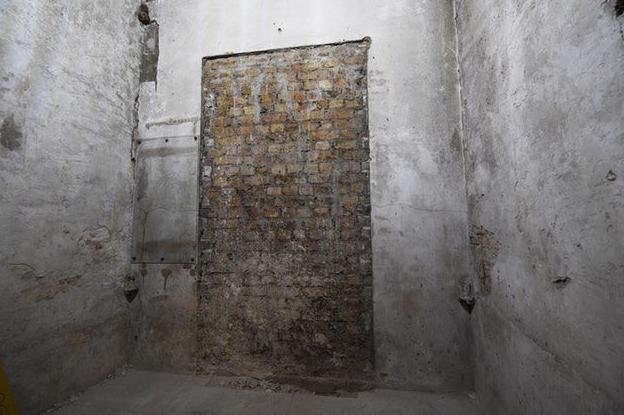
The hidden doorway was filled with bricks during reconstruction work following World War II, officials said. Photo courtesy U.K. Parliament/Jessica Taylor
Feb. 26 (UPI) -- While performing heavy renovations at London's House of Commons this week, crews uncovered a long-forgotten doorway that officials say dates back to the mid-1600s -- and was probably used by some prominent British historical figures.
The House is undergoing a $5 billion restoration project and work recently found the doorway behind wooden panels. The passageway and subsequent room were originally installed for guests heading to the celebratory banquet at the 1660 coronation of Charles II, and was later used by lawmakers to access the Palace of Westminster, a medieval building where Parliament convened until the structure burned in an 1834 fire.
In a small room beyond the door, researchers found the original hinges for two wooden doors that would have opened into the old Westminster building.
The doorway was filled in with bricks during reconstruction work after the expansive legislative building was bombed in World War II.
RELATED Cracks actually protect historical paintings against environmental fluctuation
Experts say among those who likely used the doorway in the 17th century were Robert Walpole, Britain's first prime minister, statesman William Pitt the Younger and diarist Samuel Pepys.
Crews also found graffiti -- in pencil -- from 1851 when bricklayers closed part of the doorway. It read, "This room was enclosed by Tom Porter who was very fond on Ould Ale."
More graffiti read, "These masons were employed refacing these groines August 11th 1851 Real Democrats," a reference to a movement that called for all British men to have the right to vote.
RELATED Washington Monument reopens after 3-year upgrade to elevator, security
"To think that this walkway has been used by so many important people over the centuries is incredible," said House of Commons Speaker Lindsay Hoyle. "I am so proud of our staff for making this discovery and I really hope this space is celebrated for what it is, a part of our parliamentary history."
"We were trawling through 10,000 uncatalogued documents relating to the palace at the Historic England archives in Swindon, when we found plans for the doorway in the cloister behind Westminster Hall," said University of York historical consultant Liz Hallam Smith. "As we looked at the paneling closely, we realized there was a tiny brass keyhole that no one had really noticed before, believing it might just be an electricity cupboard. Once a key was made for it, the paneling opened up like a door into this secret entrance."
The hidden room even had working electricity, they said. After researchers opened the doors, they turned on a single, still-functioning light bulb that experts guess was probably installed during post-World War II restoration.
No comments:
Post a Comment